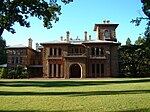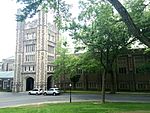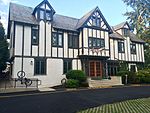First College
1961 establishments in New JerseyBuildings and structures in Princeton, New JerseyColleges of Princeton UniversityName changes due to the George Floyd protestsUniversity and college buildings completed in 1961 ... and 1 more
Use mdy dates from June 2020

First College (known as Woodrow Wilson College from 1966 to 2020), the first of Princeton University's six residential colleges, was developed in the late 1950s when a group of students formed the Woodrow Wilson Lodge as an alternative to the eating clubs. The Woodrow Wilson Lodge members originally met and dined in Madison Hall, which is now part of John D. Rockefeller III College. Inspired by the ideas of Woodrow Wilson, president of Princeton from 1902–1910, the members advocated a more thorough integration of academic, social and residential life on campus.
Excerpt from the Wikipedia article First College (License: CC BY-SA 3.0, Authors, Images).First College
Tilghman Walk,
Geographical coordinates (GPS) Address Nearby Places Show on map
Geographical coordinates (GPS)
| Latitude | Longitude |
|---|---|
| N 40.344826 ° | E -74.656203 ° |
Address
Tilghman Walk
08544
New Jersey, United States
Open on Google Maps










